Abstract
Selenium (Se) deficiency produced up to a 14-fold decrease in hepatic tri-iodothyronine (T3) production from thyroxine (T4) in vitro. The T3 production rate could not be restored by the addition of a variety of cofactors, nor by the addition of control homogenate. The impairment in hepatic T3 production observed in Se deficiency was reflected in the concentrations of thyroid hormones circulating in plasma, T4 being increased approx. 40% and T3 being decreased by 30%. However, the fall in plasma T3 concentrations was smaller than might be expected in view of the marked decreased in T3 production. Se deficiency had no measurable effect on plasma reverse-tri-iodothyronine concentrations. The data suggest that Se deficiency produces an inhibition of both 5- and 5'-deiodination, consistent with the widely held view that these reactions are catalysed by the same enzyme complex. The mechanism of inhibition appears not be mediated by changes in thiol levels, but a direct role of Se in the activity of the deiodinase complex cannot be excluded.
Full text
PDF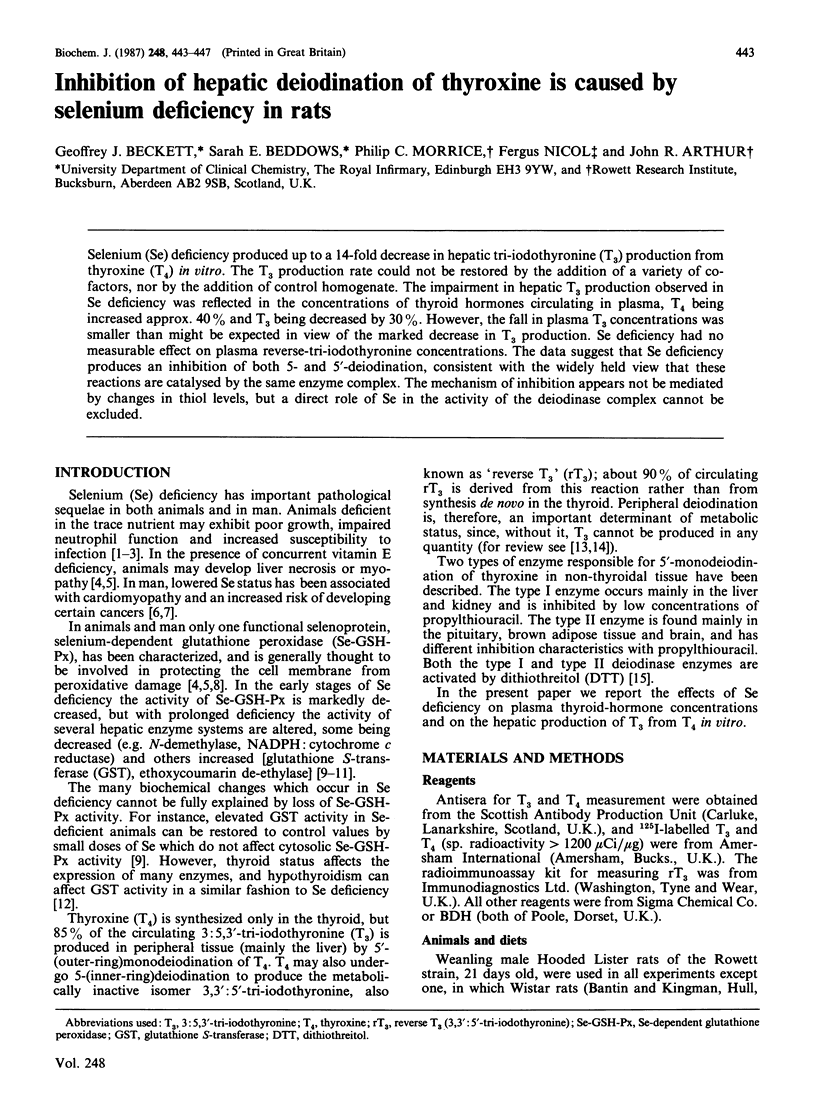
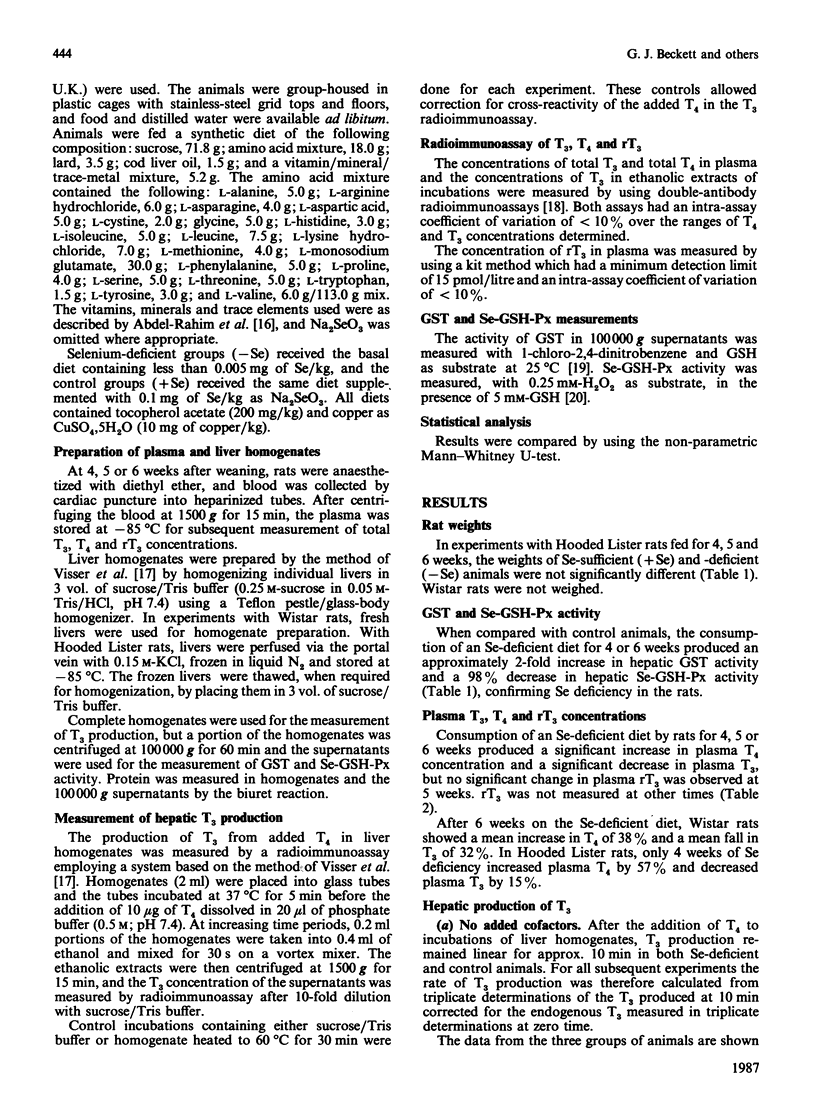
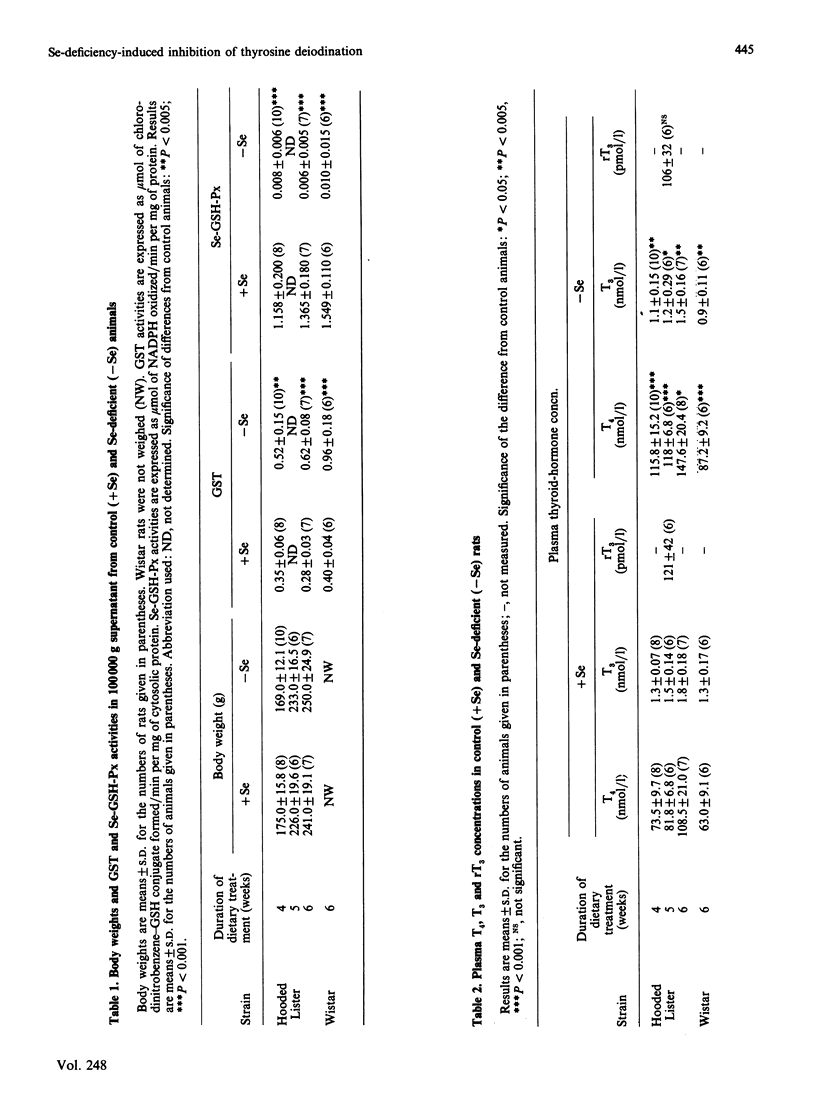
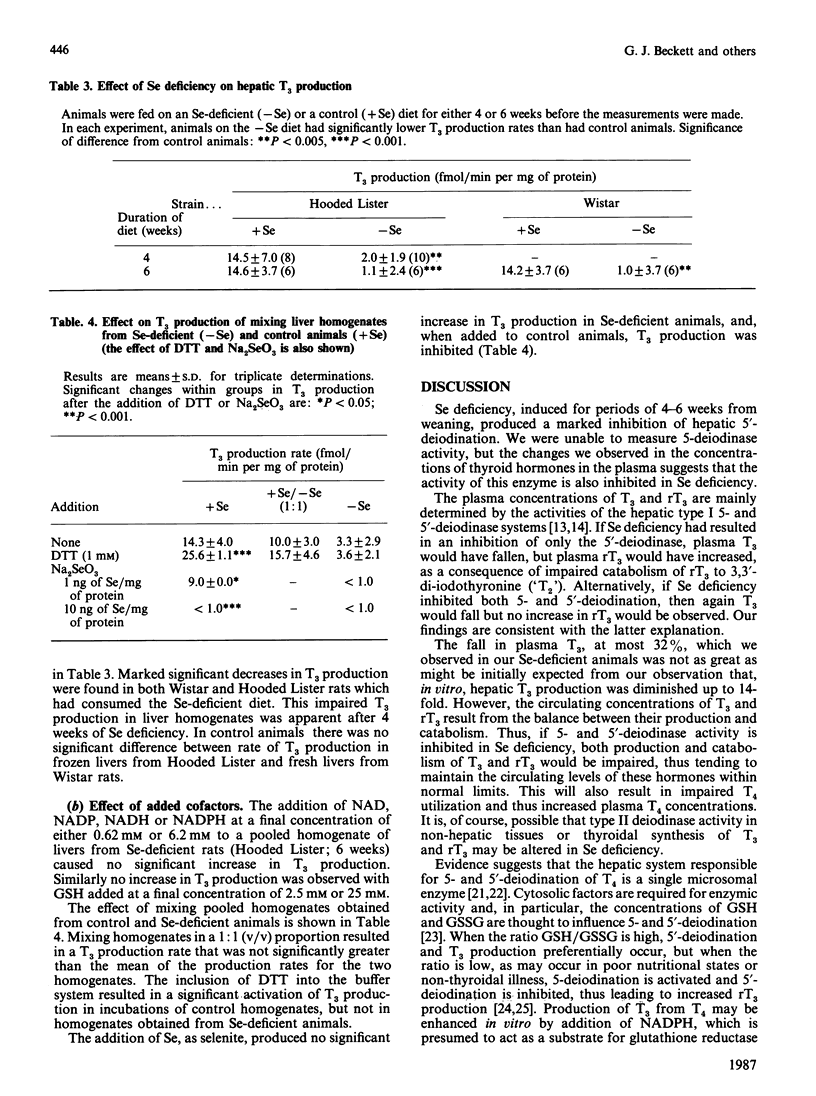
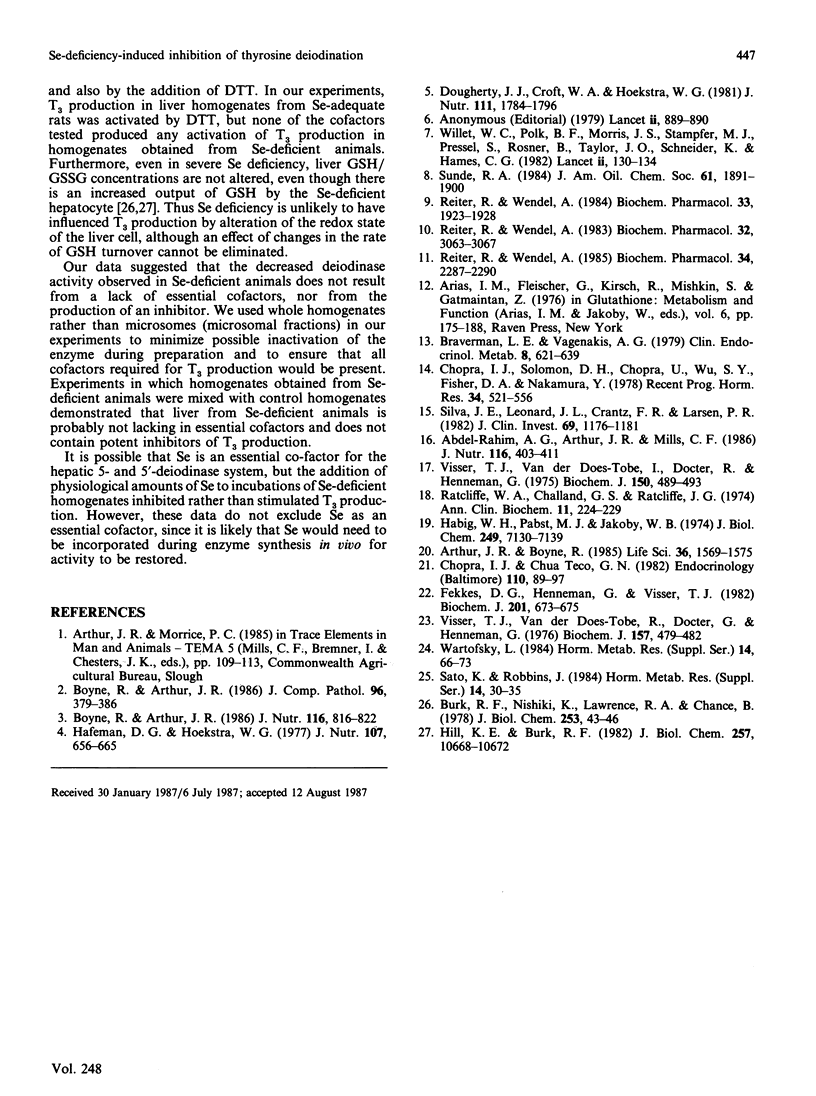
Selected References
These references are in PubMed. This may not be the complete list of references from this article.
- Abdel Rahim A. G., Arthur J. R., Mills C. F. Effects of dietary copper, cadmium, iron, molybdenum and manganese on selenium utilization by the rat. J Nutr. 1986 Mar;116(3):403–411. doi: 10.1093/jn/116.3.403. [DOI] [PubMed] [Google Scholar]
- Arthur J. R., Boyne R. Superoxide dismutase and glutathione peroxidase activities in neutrophils from selenium deficient and copper deficient cattle. Life Sci. 1985 Apr 22;36(16):1569–1575. doi: 10.1016/0024-3205(85)90381-9. [DOI] [PubMed] [Google Scholar]
- Boyne R., Arthur J. R. The response of selenium-deficient mice to Candida albicans infection. J Nutr. 1986 May;116(5):816–822. doi: 10.1093/jn/116.5.816. [DOI] [PubMed] [Google Scholar]
- Boyne R., Arthur J. R., Wilson A. B. An in vivo and in vitro study of selenium deficiency and infection in rats. J Comp Pathol. 1986 Jul;96(4):379–386. doi: 10.1016/0021-9975(86)90033-2. [DOI] [PubMed] [Google Scholar]
- Braverman L. E., Vagenakis A. G. The thyroid. Clin Endocrinol Metab. 1979 Nov;8(3):621–639. doi: 10.1016/s0300-595x(79)80034-1. [DOI] [PubMed] [Google Scholar]
- Burk R. F., Nishiki K., Lawrence R. A., Chance B. Peroxide removal by selenium-dependent and selenium-independent glutathione peroxidases in hemoglobin-free perfused rat liver. J Biol Chem. 1978 Jan 10;253(1):43–46. [PubMed] [Google Scholar]
- Chopra I. J., Chua Teco G. N. Characteristics of inner ring (3 or 5) monodeiodination of 3,5-diiodothyronine in rat liver: evidence suggesting marked similarities of inner and outer ring deiodinases for iodothyronines. Endocrinology. 1982 Jan;110(1):89–97. doi: 10.1210/endo-110-1-89. [DOI] [PubMed] [Google Scholar]
- Chopra I. J., Solomon D. H., Chopra U., Wu S. Y., Fisher D. A., Nakamura Y. Pathways of metabolism of thyroid hormones. Recent Prog Horm Res. 1978;34:521–567. doi: 10.1016/b978-0-12-571134-0.50018-1. [DOI] [PubMed] [Google Scholar]
- Conversion of thyroxine into tri-iodothyronine by rat liver homogenate. Biochem J. 1975 Sep;150(3):489–493. doi: 10.1042/bj1500489. [DOI] [PMC free article] [PubMed] [Google Scholar]
- Dougherty J. J., Croft W. A., Hoekstra W. G. Effects of ferrous chloride and iron dextran on lipid peroxidation in vivo in vitamin E and selenium adequate and deficient rats. J Nutr. 1981 Oct;111(10):1784–1796. doi: 10.1093/jn/111.10.1784. [DOI] [PubMed] [Google Scholar]
- Fekkes D., Hennemann G., Visser T. J. Evidence for a single enzyme in rat liver catalysing the deiodination of the tyrosyl and the phenolic ring of iodothyronines. Biochem J. 1982 Mar 1;201(3):673–676. doi: 10.1042/bj2010673. [DOI] [PMC free article] [PubMed] [Google Scholar]
- Habig W. H., Pabst M. J., Jakoby W. B. Glutathione S-transferases. The first enzymatic step in mercapturic acid formation. J Biol Chem. 1974 Nov 25;249(22):7130–7139. [PubMed] [Google Scholar]
- Hafeman D. G., Hoekstra W. G. Protection against carbon tetrachloride-induced lipid peroxidation in the rat by dietary vitamin E, selenium, and methionine as measured by ethane evolution. J Nutr. 1977 Apr;107(4):656–665. doi: 10.1093/jn/107.4.656. [DOI] [PubMed] [Google Scholar]
- Hill K. E., Burk R. F. Effect of selenium deficiency and vitamin E deficiency on glutathione metabolism in isolated rat hepatocytes. J Biol Chem. 1982 Sep 25;257(18):10668–10672. [PubMed] [Google Scholar]
- Ratcliffe W. A., Challand G. S., Ratcliffe J. G. A critical evaluation of separation methods in radiommunoassay for total triiodothyronine and thyroxine in unextracted human serum. Ann Clin Biochem. 1974 Nov;11(6):224–229. doi: 10.1177/000456327401100166. [DOI] [PubMed] [Google Scholar]
- Reiter R., Wendel A. Selenium and drug metabolism--I. Multiple modulations of mouse liver enzymes. Biochem Pharmacol. 1983 Oct 15;32(20):3063–3067. doi: 10.1016/0006-2952(83)90250-2. [DOI] [PubMed] [Google Scholar]
- Reiter R., Wendel A. Selenium and drug metabolism--II. Independence of glutathione peroxidase and reversibility of hepatic enzyme modulations in deficient mice. Biochem Pharmacol. 1984 Jun 15;33(12):1923–1928. doi: 10.1016/0006-2952(84)90548-3. [DOI] [PubMed] [Google Scholar]
- Reiter R., Wendel A. Selenium and drug metabolism--III. Relation of glutathione-peroxidase and other hepatic enzyme modulations to dietary supplements. Biochem Pharmacol. 1985 Jul 1;34(13):2287–2290. doi: 10.1016/0006-2952(85)90783-x. [DOI] [PubMed] [Google Scholar]
- Sato K., Robbins J. Does glutathione regulate thyroxine deiodinase activity in cells? Horm Metab Res Suppl. 1984;14:30–35. [PubMed] [Google Scholar]
- Silva J. E., Leonard J. L., Crantz F. R., Larsen P. R. Evidence for two tissue-specific pathways for in vivo thyroxine 5'-deiodination in the rat. J Clin Invest. 1982 May;69(5):1176–1184. doi: 10.1172/JCI110554. [DOI] [PMC free article] [PubMed] [Google Scholar]
- Visser T. J., Does-Tobé I., Docter R., Hennemann G. Subcellular localization of a rat liver enzyme converting thyroxine into tri-iodothyronine and possible involvement of essential thiol groups. Biochem J. 1976 Aug 1;157(2):479–482. doi: 10.1042/bj1570479. [DOI] [PMC free article] [PubMed] [Google Scholar]


